正版乳腺教案
- 格式:ppt
- 大小:5.10 MB
- 文档页数:41
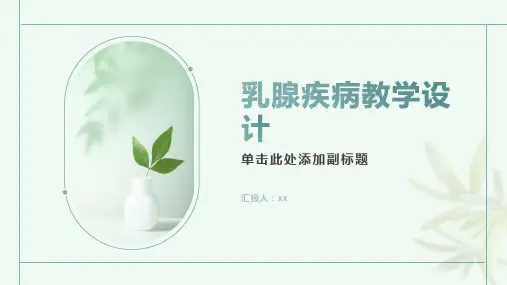
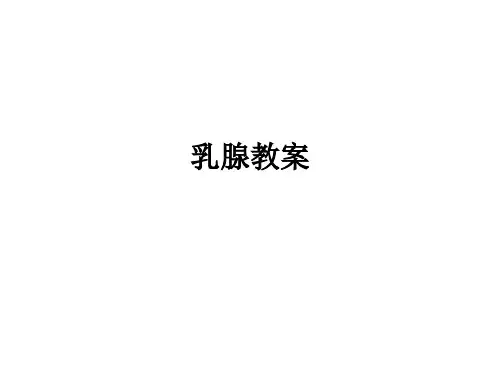

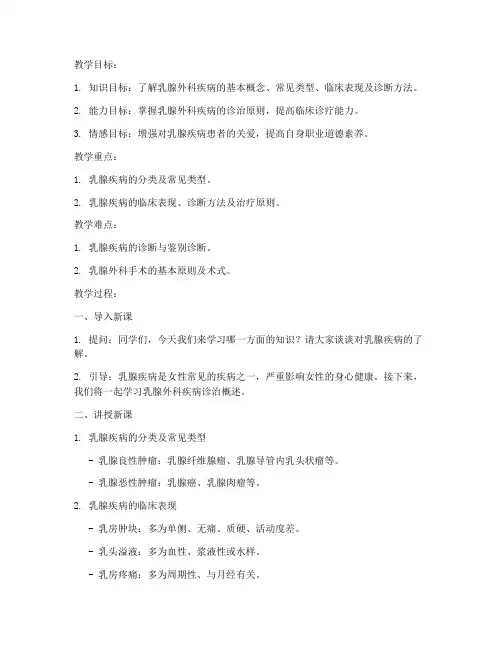
教学目标:1. 知识目标:了解乳腺外科疾病的基本概念、常见类型、临床表现及诊断方法。
2. 能力目标:掌握乳腺外科疾病的诊治原则,提高临床诊疗能力。
3. 情感目标:增强对乳腺疾病患者的关爱,提高自身职业道德素养。
教学重点:1. 乳腺疾病的分类及常见类型。
2. 乳腺疾病的临床表现、诊断方法及治疗原则。
教学难点:1. 乳腺疾病的诊断与鉴别诊断。
2. 乳腺外科手术的基本原则及术式。
教学过程:一、导入新课1. 提问:同学们,今天我们来学习哪一方面的知识?请大家谈谈对乳腺疾病的了解。
2. 引导:乳腺疾病是女性常见的疾病之一,严重影响女性的身心健康。
接下来,我们将一起学习乳腺外科疾病诊治概述。
二、讲授新课1. 乳腺疾病的分类及常见类型- 乳腺良性肿瘤:乳腺纤维腺瘤、乳腺导管内乳头状瘤等。
- 乳腺恶性肿瘤:乳腺癌、乳腺肉瘤等。
2. 乳腺疾病的临床表现- 乳房肿块:多为单侧、无痛、质硬、活动度差。
- 乳头溢液:多为血性、浆液性或水样。
- 乳房疼痛:多为周期性、与月经有关。
3. 乳腺疾病的诊断方法- 体格检查:注意乳房形状、大小、肿块质地、活动度等。
- 影像学检查:乳腺超声、乳腺钼靶、MRI等。
- 病理检查:穿刺活检、手术切除等。
4. 乳腺疾病的诊治原则- 早期诊断、早期治疗。
- 针对不同类型的乳腺疾病,采取个体化治疗方案。
- 治疗方法包括:药物治疗、手术治疗、放疗、化疗等。
5. 乳腺外科手术的基本原则及术式- 术前准备:完善各项检查,制定手术方案。
- 术中操作:严格无菌操作,注意解剖层次。
- 术后护理:观察病情变化,预防并发症。
三、课堂讨论1. 乳腺疾病的诊断与鉴别诊断有哪些?2. 乳腺外科手术有哪些术式?3. 如何提高乳腺疾病的早期诊断率?四、课堂小结1. 总结乳腺疾病的分类、临床表现、诊断方法及诊治原则。
2. 强调早期诊断、早期治疗的重要性。
五、课后作业1. 阅读相关资料,了解乳腺疾病的最新研究进展。
2. 结合临床案例,分析乳腺疾病的诊断与鉴别诊断。
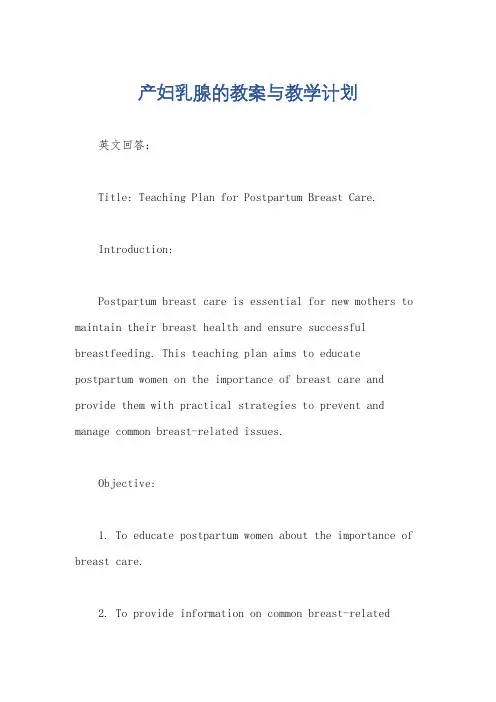
产妇乳腺的教案与教学计划英文回答:Title: Teaching Plan for Postpartum Breast Care.Introduction:Postpartum breast care is essential for new mothers to maintain their breast health and ensure successful breastfeeding. This teaching plan aims to educate postpartum women on the importance of breast care and provide them with practical strategies to prevent and manage common breast-related issues.Objective:1. To educate postpartum women about the importance of breast care.2. To provide information on common breast-relatedissues and their management.3. To teach proper breastfeeding techniques and positions.4. To promote self-care and early detection of breast problems.Teaching Methods:1. Lecture: Provide a comprehensive overview of postpartum breast care, including the importance of breast hygiene, nipple care, and breast massage techniques.2. Demonstration: Show proper breastfeeding techniques and positions using a doll or breastfeeding aid.3. Group Discussion: Encourage participants to share their breastfeeding experiences and discuss common challenges and solutions.4. Handouts: Provide written materials summarizing keypoints discussed during the session for participants totake home.Content:1. Importance of Breast Care:Explain the benefits of breastfeeding for both the mother and the baby.Emphasize the role of breast care in preventing common breastfeeding problems such as engorgement, mastitis, and cracked nipples.Discuss the importance of maintaining proper breast hygiene to prevent infection.2. Common Breast-Related Issues and Management:Explain the signs and symptoms of engorgement, mastitis, and blocked ducts.Teach participants how to relieve engorgement through techniques such as warm compresses, breast massage, and frequent breastfeeding.Provide information on the management of mastitis, including the importance of rest, proper nutrition, and antibiotics if necessary.Discuss strategies to prevent and manage blocked ducts, such as frequent feeding, proper positioning, and gentle massage.3. Proper Breastfeeding Techniques and Positions:Demonstrate different breastfeeding positions,including the cradle hold, football hold, and side-lying position.Teach participants how to ensure a good latch and proper milk transfer.Discuss the importance of breastfeeding on demand andavoiding the use of pacifiers or bottles in the early weeks.4. Self-Care and Early Detection:Encourage participants to perform regular breast self-examinations to detect any changes or abnormalities.Teach participants how to recognize signs of breast infection or other complications and when to seek medical help.Discuss the importance of rest, proper nutrition, and hydration for maintaining breast health.Evaluation:Conduct a short quiz or questionnaire at the end of the session to assess participants' understanding of the material.Encourage participants to ask questions and provide feedback on the teaching session.Conclusion:By providing postpartum women with knowledge and practical strategies for breast care, this teaching plan aims to empower them to take control of their breast health and ensure successful breastfeeding. Regular education and support can significantly contribute to the well-being of both the mother and the baby.中文回答:标题,产妇乳腺护理的教案与教学计划。

课时安排:2课时教学目标:1. 让学生掌握乳腺外科的基本概念和范畴。
2. 熟悉乳腺解剖结构及生理功能。
3. 了解乳腺疾病的常见类型及其临床表现。
4. 掌握乳腺疾病的诊断、治疗原则及手术方法。
教学重点:1. 乳腺解剖结构及生理功能。
2. 乳腺疾病的常见类型及诊断。
3. 乳腺肿瘤的手术方法。
教学难点:1. 乳腺疾病的鉴别诊断。
2. 乳腺肿瘤的手术适应症及禁忌症。
教学过程:第一课时一、导入1. 结合实际案例,引导学生关注乳腺健康。
2. 介绍乳腺外科的基本概念和范畴。
二、教学内容1. 乳腺解剖与生理功能- 介绍乳腺的解剖结构,包括腺体、导管、脂肪组织等。
- 讲解乳腺的生理功能,如分泌乳汁、参与内分泌调节等。
2. 乳腺疾病的常见类型及诊断- 介绍乳腺疾病的常见类型,如乳腺增生、乳腺炎、乳腺肿瘤等。
- 讲解乳腺疾病的诊断方法,如乳腺超声、乳腺钼靶、乳腺MRI等。
三、案例分析1. 结合实际案例,分析乳腺疾病的诊断与治疗过程。
2. 讨论乳腺疾病的预防措施。
四、课堂小结1. 总结本节课所学内容,强调乳腺健康的重要性。
2. 布置课后作业,要求学生查阅相关资料,了解乳腺疾病的最新研究进展。
第二课时一、导入1. 回顾上一节课所学内容,提出本节课的学习目标。
2. 强调乳腺肿瘤的手术方法。
二、教学内容1. 乳腺肿瘤的手术方法- 介绍乳腺肿瘤的手术适应症及禁忌症。
- 讲解乳腺肿瘤的手术方法,如乳腺肿块切除术、乳腺根治术、乳房重建术等。
2. 乳腺肿瘤的术后护理- 介绍乳腺肿瘤术后患者的护理要点,如伤口护理、饮食调理、心理疏导等。
三、案例分析1. 结合实际案例,分析乳腺肿瘤的手术适应症及禁忌症。
2. 讨论乳腺肿瘤术后患者的护理措施。
四、课堂小结1. 总结本节课所学内容,强调乳腺肿瘤的手术方法及术后护理。
2. 布置课后作业,要求学生查阅相关资料,了解乳腺外科的最新研究成果。
教学评价:1. 课堂表现:观察学生在课堂上的参与度、提问情况等。

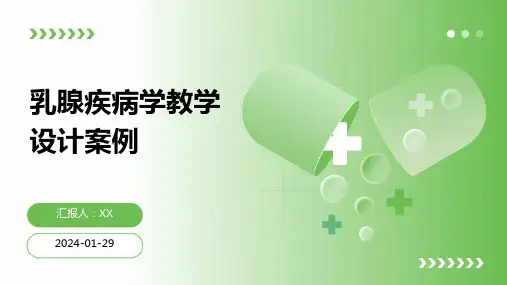
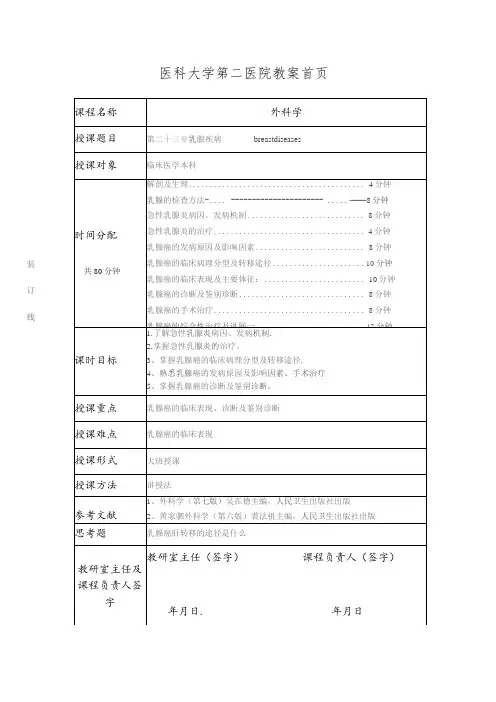
医科大学第二医院教案首页
装
订
线
三苯氧胺的用量为第天20-80mg,但增加量并不一定能提高疗效,不良反应有恶心、呕吐、发热、外阴瘙痒、阴道流血等,偶有脱发、白细胞降低,少数病例可引起卵巢囊肿、肝功能障碍以及增加子宫内膜癌发生的机会。
(四)放射治疗:乳腺癌应用放射线治疗已有100年的历史,但在早年,仅作为术后补充治疗或晚期、复发病例的姑息治疗。
直至1941年MCWhirter首先用单纯乳房切除加放疗来代替根治术,使放疗在乳腺癌的治疗中跨进了一步。
指征如下:①病理报告有腋中及腋上组淋巴结转移②阳性淋巴结占淋巴结总数1/2以上或有四个以上淋巴结阳性者③病理证实胸骨旁淋巴结阳性者尤其是腋淋巴结阳性者。
(五)生物学治疗:。

乳腺疾病教案教案标题:乳腺疾病教案教案目标:1. 了解乳腺疾病的常见类型和病因。
2. 掌握预防乳腺疾病的方法和重要性。
3. 学会自我检查乳腺的方法和频率。
4. 了解乳腺疾病的早期症状和就医建议。
教学内容:1. 乳腺疾病的常见类型和病因:a. 乳腺增生b. 乳腺囊肿c. 乳腺炎d. 乳腺癌e. 病因包括遗传因素、荷尔蒙水平、饮食习惯等。
2. 预防乳腺疾病的方法和重要性:a. 健康饮食:摄入适量的蔬菜、水果、全谷物和低脂乳制品。
b. 锻炼身体:保持适度的身体活动,如散步、慢跑等。
c. 避免吸烟和酗酒。
d. 定期体检和乳腺筛查。
3. 自我检查乳腺的方法和频率:a. 洗澡时用手指轻轻触摸乳房,检查是否有肿块、硬块或异常感觉。
b. 每月在月经后的第7-10天进行自我检查。
c. 学会正确的自我检查方法,包括观察、触摸和检查乳头有无溢液。
4. 乳腺疾病的早期症状和就医建议:a. 早期症状包括乳房肿块、疼痛、乳头溢液等。
b. 就医建议:如果发现任何异常症状,应及时就医进行进一步检查和诊断。
教学步骤:1. 引入:介绍乳腺疾病的重要性和对女性健康的影响。
2. 讲解乳腺疾病的常见类型和病因,并展示相关图片或视频材料。
3. 探讨预防乳腺疾病的方法和重要性,鼓励学生分享自己的健康习惯。
4. 演示自我检查乳腺的方法和频率,让学生模仿进行实际操作。
5. 分组讨论乳腺疾病的早期症状和就医建议,并分享各自的观点和经验。
6. 总结课堂内容,强调乳腺疾病的重要性和预防措施。
7. 布置作业:要求学生在家自我检查乳腺,并记录自己的观察结果。
教学资源:1. 乳腺疾病相关的图片或视频材料。
2. 自我检查乳腺的图示或视频示范。
3. 乳腺疾病预防宣传资料。
评估方法:1. 学生课堂参与度和讨论表现。
2. 学生完成的作业,包括自我检查乳腺的记录。
3. 学生对乳腺疾病的理解和预防措施的口头回答。
教案提示:1. 鼓励学生互相分享自己或家人朋友的乳腺健康经历,增加课堂互动和实际案例。

教学对象:临床医学专业学生教学时间:2课时教学目标:1. 了解乳腺外科疾病的基本概念、病因、病理生理变化。
2. 掌握乳腺外科常见疾病的诊断、治疗原则及手术方法。
3. 了解乳腺外科疾病诊疗的进展,提高临床诊疗水平。
教学内容:一、乳腺外科疾病概述1. 乳腺疾病的概念、分类2. 乳腺疾病的病因及病理生理变化二、乳腺外科常见疾病1. 乳腺癌(1)临床表现(2)诊断(3)治疗原则(4)手术方法(5)乳腺癌的诊疗进展2. 乳腺良性肿瘤(1)临床表现(2)诊断(3)治疗原则(4)手术方法三、乳腺外科疾病诊疗进展1. 乳腺癌保乳手术及乳房再造技术2. 乳腺癌前哨淋巴结活检技术3. 乳腺纤维导管镜技术4. 静脉输液港技术教学过程:一、导入新课1. 提问:同学们,你们知道乳腺外科疾病有哪些吗?2. 学生回答,教师总结:乳腺外科疾病包括乳腺癌、乳腺良性肿瘤等。
二、讲授新课1. 讲授乳腺外科疾病概述,让学生了解乳腺疾病的基本概念、病因、病理生理变化。
2. 讲授乳腺外科常见疾病,重点讲解乳腺癌和乳腺良性肿瘤的诊断、治疗原则及手术方法。
3. 讲授乳腺外科疾病诊疗进展,介绍乳腺癌保乳手术及乳房再造技术、乳腺癌前哨淋巴结活检技术、乳腺纤维导管镜技术、静脉输液港技术等。
三、课堂讨论1. 提问:同学们,你们认为如何提高乳腺外科疾病的诊疗水平?2. 学生分组讨论,教师总结:提高乳腺外科疾病的诊疗水平需要加强医学知识的学习,掌握先进的诊疗技术,注重临床实践。
四、课堂小结1. 回顾本节课所学内容,强调重点知识。
2. 布置课后作业,要求学生查阅相关资料,了解乳腺外科疾病的最新研究进展。
教学评价:1. 课后作业:检查学生对本节课所学知识的掌握程度。
2. 课堂讨论:评价学生的参与度和表达能力。
3. 期末考试:检测学生对乳腺外科疾病诊疗知识的掌握情况。